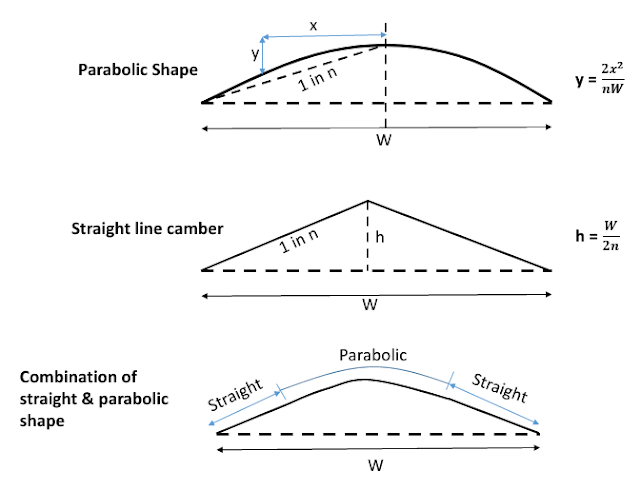CAMBER
Camber or Cross Slope is the slope provided to the road surface in the transverse direction to drain off rain water from the road surface.
Objects/Purposes of providing camber :
- To remove the rain water from the pavement surface as quickly as possible and to allow the pavement to get dry soon after the rain so that skid resistance of the road surface can be increased.
- To prevent entry of water into the bituminous pavement layers, as continued contact with water causes stripping of bitumen from the aggregates and results in deterioration of the pavement layer.
- To prevent the entry of surface water into the subgrade soil through pavement.
- The stability and surface condition of the pavement get adversely affected if the water enters into the subgrade and the soil gets soaked.
- To make the pavement surface attractive.
The rate of camber is usually designated by 1 in n (1 vertical to n horizontal).
Camber is also expressed as a percentage.
If the camber is x%, the cross slope is x in 100.
The values of camber recommended by the IRC for different types of road surface are given in the table below :
The required camber of a pavement depends on :
- The type of pavement surface
- The amount of rain fall
A flat camber of 1.7 to 2.0 % is sufficient on relatively impervious pavement surface like cement concrete or bituminous concrete. In pervious surface like WBM or earth road which may allow surface water to get into the subgrade soil, steeper camber is required.
A steeper camber may give rise to the following disadvantages:
- The vehicles have a tendency to keep to the centre thereby causing comparatively quicker deterioration in the central portion.
- Vehicles running at high speeds are likely to slip towards the edges.
- The comparatively high velocity of water from the pavement would erode the berm.
- The transverse tilt of vehicles causes uncomfortable side thrust and a drag on the steering of vehicles.
- Discomfort causing throw of vehicle when crossing the crown during overtaking operations.
Ways of Providing Camber :
There are three ways of providing the camber;
- Parabolic camber
- Straight camber
- Combination of straight and parabolic camber


